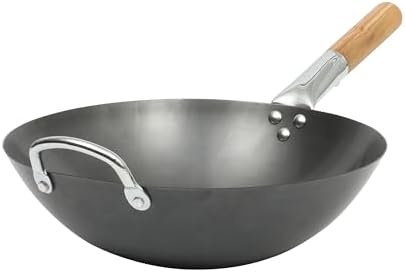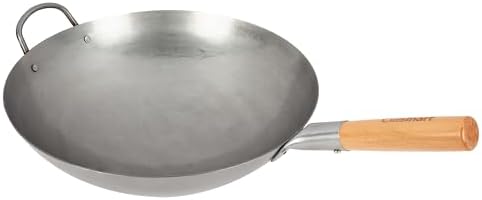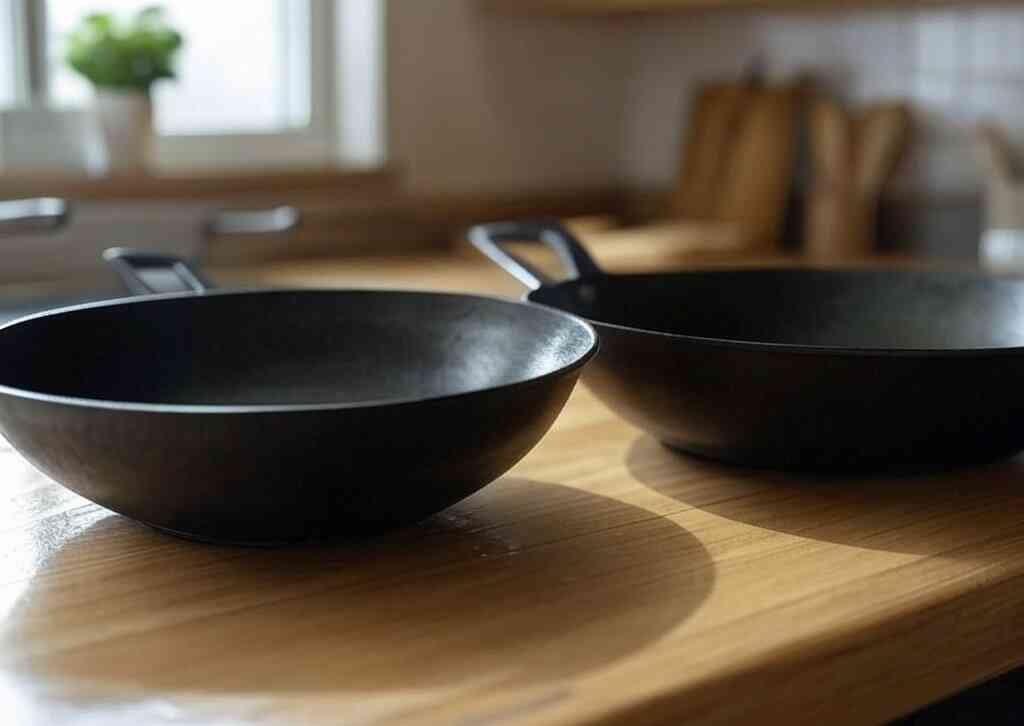Grasping Carbon Steel Woks
Carbon steel woks are some of the best-loved by chefs and home cooks. They do this because they conduct heat well and are versatile, they consist of carbon and iron and are lighter than cast iron woks. They are therefore easy to manage while cooking, possess one significant advantage in the sense that they heat up quickly, also preserve high temperatures. This is essential for searing, stir-frying, and browning food rapidly.
The other unique characteristic is their adaptive cooking surface. Non-stick pans are unique in that carbon steel woks need seasoning. Seasoning creates a natural non-stick coating with time. This enhances cooking by preventing sticking. It also imparts flavor to the wok. Seasoning the wok involves a thin layer of oil and heating it. This allows the oil to polymerize and create a protective coating. This distinguishes carbon steel woks and is necessary for best performance.
Care and maintenance are essential to ensure the long life of a carbon steel wok. Gently clean the wok after every use with a sponge and hot water. Do not use abrasive pads, which can strip the seasoned surface. Dry the wok thoroughly after washing to avoid rust. Apply oil regularly, particularly after washing. This maintains the seasoning and keeps the wok in its best shape. By knowing these things, beginners will be able to get the best out of their wok. They can utilize it for years.
Bypassing the Seasoning Process
A common beginner mistake is failing to season a carbon steel wok sufficiently. Seasoning is the basis of a non-stick. It also saves the wok from rust and damage. The process involves applying oil and heating it. This creates a polymerized coat. It induces better flavor and better cooking.
Seasoning starts with scrubbing the wok clean. This removes any factory residue like oils or coatings. After that, dry the wok thoroughly. Then, apply a high smoke point oil evenly. Vegetable or grapeseed oil is a suitable option. Put the wok on the stove and heat until the oil smokes. This forms a non-stick coating. Do this initial seasoning a few times. This forms a thicker coating. This makes food release easier and less sticking.
Ignoring seasoning causes numerous issues. A poorly seasoned wok will rust quickly. It will also respond to acidic foods. It can transfer nasty tastes to food as well. Sticking of food while cooking in such a wok can occur. This makes cooking frustrating. Periodic seasoning maintenance is also required. Lesser water and no abrasive chemicals should be used to clean it. This preserves the coating. Also, apply a thin layer of oil after cleaning. This prevents water accumulation and gives long-lasting performance.
By prioritizing seasoning and recognizing its value, beginners will improve their cooking. They will have improved taste, effectiveness, and simpler long-term care.
Mistake #2: Using the Wrong Utensils
When cooking with a carbon steel wok, the use of utensils matters. It determines results and shelf life of cookware. One of the common mistakes that novices make is using metal spoons and spatulas. Spoons and spatulas scratch and ruin the seasoning coat. It is a breach in the non-stick process. It leads to food sticking and a poor cooking experience.
To prevent this, use soft cutlery. Wooden cutlery is ideal. They are durable and naturally non-scratch. They give good stirring and turning without scratching the seasoning. Silicone cutlery can be used too. They offer heat resistance and flexibility. The softness of these materials protects the coating of the wok. This ensures that it will continue to perform its best in the long term.
Also, avoid using abrasive cleaning pads. They strip the seasoned layer. The seasoned layer is important for the non-stick effect you desire. Rather than abrasive cleaning pads, make use of soft cloths or sponges. They clean the surface without changing its quality. With the right utensils and cleaning methods, you can maximize your cooking significantly. You can even prolong the life of your carbon steel wok.
All in all, the choice of tools is important. Use wood or silicone tools. Combine them with gentle ways of cleaning. This does not damage the seasoning layer. This also leads to better cooking outcomes. Executing these techniques will turn your wok into a reliable kitchen partner for years to come.
Error #3: Overcrowding the Wok
When a carbon steel wok is used, the typical novice error is overstuffing it with food. This can really slow down cooking. It causes steaming rather than stir-frying. When excessive food is in the wok all together, the heat decreases. This does not allow the ingredients to brown adequately. Consequently, instead of crispiness and well-differentiated flavors, the food is soggy and tasteless.
In order to cook as effectively as possible, half fill the wok. This allows all ingredients enough space to be in contact with the hot bottom. This assures balanced cooking and richer flavor. The rule of thumb is to cook in small batches. This can take longer, but the result will be far superior. They will be well worth the extra effort.
Moreover, high heat is necessary to be maintained while stir-frying in a carbon steel wok. High heat allows for speedy cooking. This maintains the texture and nutrients of the food. Food cannot be cooked or kept at high heat when packed too tightly. This renders the stir-fry lose even its authenticity. Remember that a successful stir-fry translates to speedy cooking time and unceasing wok moving.
Lastly, don’t overcrowd your carbon steel wok. This will provide your dishes with a good texture and flavor. It will also make cooking much easier. With the focus on these useful tips, beginners can easily master stir-frying. They can have restaurant-quality dishes at home.











